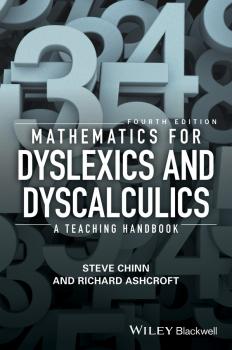Steve Chinn
Список книг автора Steve ChinnMathematics for Dyslexics
Mathematics for Dyslexics: Including Dyscalculia, 3rd Edition discusses the factors that contribute to the potential difficulties many dyslexic learners may have with mathematics, and suggests ways of addressing these difficulties. The first chapters consider the theoretical background. The later chapters look at practical methods, which may help dyslexic learners. The book is designed to be comprehensive and to help teachers, support assistants, and parents understand the learner and to learn a range of skills and thus develop confidence and competence in working with dyslexic pupils.
Addressing the Unproductive Classroom Behaviours of Students with Special Needs
*Shortlisted for the 2011 NASEN Award 'Book to Promote Professional Development'* Certain classroom behaviours can signify an underlying learning disability. This book will help you recognise potential indicators of Asperger Syndrome, dyslexia, dyspraxia, AD/HD, physical disabilities and speech and language disorders; explores the benefits of different interventions; and offers practical strategies for improving pupils' behaviours, social skills and self-esteem. This book contains: – A simple-to-use screener for initial identification of a pupil's specific learning disability- A practical and simple structure for monitoring classroom behaviours and creating an Individual Behaviour Plan- Tried-and-tested teacher strategies for common areas of concern, such as problems staying on task, inability to work on group tasks and failure to seek help when needed- Key educational theories to help teachers understand and influence classroom behaviours, and further develop classroom management skills for addressing the behaviours of special needs pupils. This practical, accessible book is an essential tool kit for special educational needs coordinators, learning support staff and teachers in both primary and secondary schools.
Mathematics for Dyslexics and Dyscalculics. A Teaching Handbook
A seminal handbook in the field for more than 20 years, this new and updated edition of Mathematics for Dyslexicsand Dyscalculics contains the latest research and best practices for helping learners with numerical and mathematical difficulties. Provides a complete overview of theory and research in the fields of dyslexia and dyscalculia, along with detailed yet pragmatic methods to apply in the classroom Contains enhanced coverage of place value and the role of the decimal point, why fractions can challenge a developed logic for arithmetic, and the complexity of time along with new material on addressing anxiety, fear, motivation, and resilience in the classroom; and links to new resources including standardized tests and recommended reading lists Written by two mathematics teachers with 50 years of teaching experience between them, much of it in specialist settings for students with specific learning difficulties Offers effective teaching strategies for learners of all ages in a structured but accessible format


